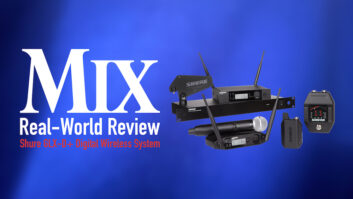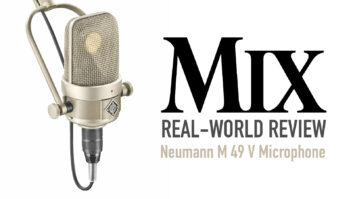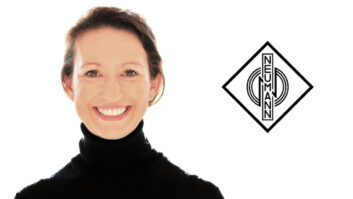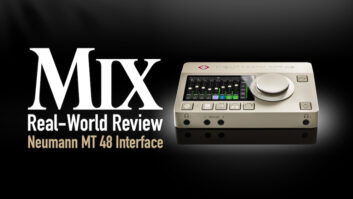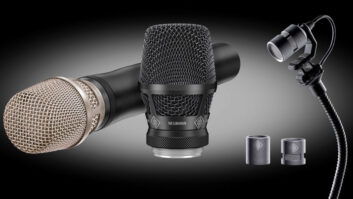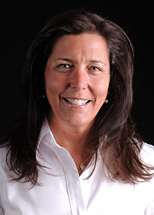
Since the DAW became an audio standard, the idea of a purely digital signal path from mic capsule to storage medium has interested more than a few engineers. That was all but a pipe dream until 2001, when Neumann — the first company to offer a condenser microphone, switchable directional response, a stereo microphone and 48-volt phantom power — lived up to its pioneering legacy with the release of the D-01 digital mic. The Solution-D large-diaphragm digital mic was truly groundbreaking, offering converters in the mic and supporting the new AES 42 standard to both transmit signal and provide synchronization and remote control of pattern, onboard DSP and other parameters. The beauty of this system is that no mic preamp is needed; gain is strictly digitally controlled in the mic itself.
The next-gen Solution-D model from Neumann, and my review unit, is the KM D Series, a small, front-address pencil mic that offers DSP, switchable capsules and, like its predecessor, remote control. It can be purchased in a nickel or black Nextel finish and comes with Neumann’s RCS (Remote-Control Software, Mac/Win). Although it is possible to run the system without the software, I found that it offers a welcome and easy-to-use interface.
DIGITAL SOLUTIONS
The KM 184 D looks much like Neumann’s existing KM 180 and KM 100 Series analog mics. It can be operated from 44.1 up to 192 kHz without external converters, and it offers five capsule choices: the KK 131 (free-field-equalized omnidirectional), KK 143 (wide cardioid), KK 145 (cardioid with low-frequency roll-off), KK 183 (diffuse-field-equalized omnidirectional), KK 184 (cardioid) and KK 185 (hypercardioid). To operate, the mic requires a base unit: either the DMI-2 digital microphone interface or one of the less-pricey S/PDIF or AES/EBU connection kits, which can also provide battery power for remote situations. Should you want to take this concept to the next step, this past November RME released the DMC-842, an 8-channel AES 42 interface with a MADI option. At press time, it was rumored that Neumann is working on its own similar interface slated for release later this year.
I had a pair of the KM D digital mics with a few different capsules and used them on several computers and sessions with excellent results. The RCS software loaded easily and communicated with the mics without a hitch. Although I had the full range of connection kits at my disposal, the DMI-2 was the only choice for me, as the smaller, portable connection kit doesn’t allow you to change levels or have any other mic control or options. The mic itself will store the DMI-2’s settings for use with the smaller connection kits, but I found this scenario unworkable in a session framework where levels may need adjustment at any time. The RCS software is absolutely essential when managing gain as there is no hardware control on the DMI-2. More about that process later.
The software offers basic gain control, level meters and gain-reduction meters,plus some interesting extras. For instance, each mic has onboard DSP in the guise of a compressor/limiter, de-esser and peak limiter, which can be controlled remotely from the RCS interface. There are also three test tones: white noise, pink noise and a 1k tone generated from the mic that can be switched on and off using the software, making troubleshooting an easy venture. A quirky extra is the ability to remotely turn on and off the mic’s piercing-blue LED. Although not useful in my setup, I could see where this feature could be tied to other console or DAW functions, such as a Record button, provided that the console or DAW was AES 42 compliant.
AES 42 PIPELINE
I wanted to explore the upper ranges of the mics’ sample rates, which required 110-ohm cabling. Neumann states that regulation cabling up to 48 kHz can be used, but the manufacturer recommends an AES-standard 110-ohm cable (up to 300 feet) when you are operating the mics at any sample rate above that. This presented a problem because I was in a studio where the live room had traditional cabling in the walls with no other pass-through access readily available. My enthusiasm for hearing these mics at their best led me to Hosa, which generously provided two 120-foot (and pricey) 110-ohm AES cables so I could run them from my control room, out the door, down the hall and into the studio.
For this setup, the DMI-2 was in the control room next to the computer and was fed by the two cables from the mics. I patched a BNC word clock signal from a Pro Tools HD 192 I/O interface into the DMI-2 to provide a clock source. The DMI-2 has its own word clock that will automatically sync the mics if no external source is available. Next, I fed a Cat-5 cable out of the DMI-2 into the computer via a Cat-5/USB turnaround (provided). This connection was used to communicate to the mics through the RCS software. For the audio connection to the DAW, the DMI-2 sums the two separate AES 42 mic signals and sends them out as an AES stereo pair on a single cable, which I patched into the 192’s AES/EBU enclosure input.
LET’S HEAR THEM
I first used the mics to record three different drum kits on different sessions at 96 kHz. I employed them as cardioid overheads twice, and for the third application as a pair of room mics using omni capsules. The first thing I noticed — or actually didn’t notice — is the noise floor: It’s conspicuous by its absence. Even with the gain cranked, the signal is crystal-clear. The air at the top is open and natural, and everything else sounds even and just as it should sound: like you’re in the room.
As overheads, the mics portrayed the cymbals crisply with no brashness or clang. Tom and kick hits were tight and precise with great transient response. When the other mics were brought into the mix, the kit sounded beautiful. As room mics, the omni capsules represented the room beautifully, with great off-axis response, plenty of low end from the front of the kit, and an even and clean “roominess” from the boundaries. I found that I was able to use these overhead and room tracks with just a kick and snare drum close-mic for a great and full kit sound.
It’s worth noting that the software is simple and the GUI easily floats above your DAW’s session window. I found that once I set up the mics, I forgot about the software just as I would a mic preamp if the levels looked good. I used the integral tone generator every time I set up the mics; it’s a great added feature, allowing me to pay attention to the session setup and getting signal through the system, even if I were alone in the building.
When using the mic’s integral compressor, latency was a major issue. The software compression sounded great and works fine if the player didn’t have to hear the audio through a cue send, but in an overdub situation they’d be unusable.
I then used the pair with cardioid capsules to record an acoustic guitar, and the results were stellar. Because the mics are so clean, you hear every detail of picking and the physical sound of the human hand on an instrument. The guitar player commented that the tracks sounded just like his instrument, with little coloration throughout its range. The tone was even from top to bottom, and the air on top made it easy to stay away from any EQ.
IS IT DIGITAL TIME YET?
The sound of the KM D Series digital mics is truly delicious. In every situation, they were crystal-clear, providing an incredible level of detail and transparency. However, when setting them up, be prepared to provide some extra special infrastructure and be somewhat inconvenienced. They’d be ideal for use in an open-area recording situation like a concert hall, where you could run cables up to 300 feet without any barriers, or left set up in a personal recording space where you could set and forget. But in a traditional studio setting where setups vary, walls separate you from your source and you don’t have 110-ohm cabling throughout, you may have to jump through some hoops for optimal performance.
All that said, nothing great is ever achieved without a little extra effort, so get out your wallet and prepare to be dazzled. These mics set a new standard for recording and give purists a new path to audio nirvana. Prices: KM D Series mic with one capsule, $1,958; extra capsules, $798 each; DMI-2 2-channel interface, $1,418; AES or S/PDIF connection kit, $198.
Neumann, 860/434-9190, www.neu mannusa.com.
Kevin Becka is Mix‘s technical editor.
